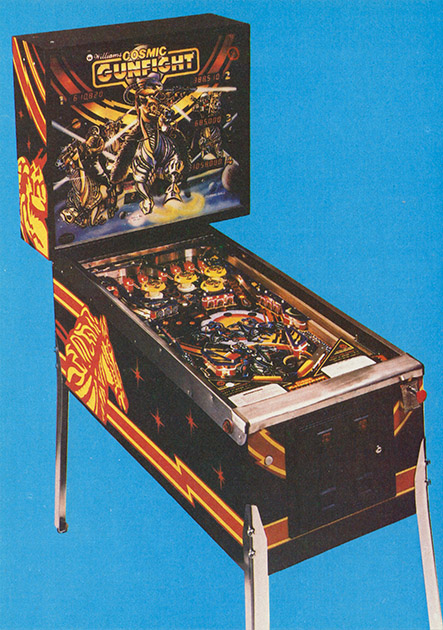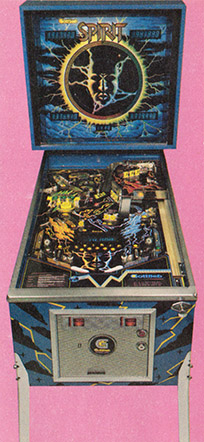
Pinball Palace
Will Flipper Games Boom in 1983?
As the year draws to a close, it’s easy to understand why diehard pin ballers have had little to flip over. In looking back at 1982, the undeniable truth is that pinball machines have journeyed through a dramatic period of transition which has set the stage for its continued survival or a place as a historical footnote in the evolution of the coin-machine industry.
To borrow a line from Mark Twain, the reports of pinball’s death are greatly exaggerated. In fact, although some might consider the past 12 months to have been the worst of times, they will also be remembered as having been the best of times. After all, we’ve witnessed the creation of a breakthrough effort—Gottlieb’s Caveman—which married the play action of both pinball and video in one game, the singularly different and perplexing bumps and rolls of Stern’s Orbitor 1 with its molded, contoured playfield and, lastly, the attempt to package a new breed of game in a pinball cabinet ala Williams’ Hyperball and Baily’s Rapid Fire. And the year isn’t even over yet.
Whatever the coming months will bring, pinballers have been treated to some very diverse challenges as manufacturers continue to pull out all stops in the hope of finding that magic formula. Even this month’s machines offer a hint as to the imaginative options still open in the design and programming of a pinball playfield.
COSMIC GUNFIGHT
Williams
Though this company has garnered most of its kudos over the past couple of years because of its videogames, Williams still remembers its heritage and, although the intensity and primary focus is not what it once was, the effort remains to turn out pinball machines. In this case, their most recent game, Cosmic Gunfight is a bit deceiving because there’s more than meets the eye in looking over the features and layout of the board.

With a variety of shots and fairly good balance from top to bottom, Cosmic Gunfight is a game for pinball purists, or as Williams is calling it, a “back-to-basics” machine with something for everyone. All in all, the conventional design, which does not bring into play a third or even second level of action, does incorporate multi-lane change (activated by the flipper buttons), multi-ball play and a potential of cosmic ball play which is really an added-on bonus turn tied into features on the board, and values collected during the course of play.
Destined to probably endure the same fate as Gottlieb’s Devil’s Dare, which on the surface didn’t look like much to those within the industry but did gain a dedicated following at many locations, Cosmic Gunfight is going to get its fair share of quarters from those willing to invest in a few plays and test their skill.
The action begins with three top lanes (1-2-3) on the right side and leads down to a middle area of four thumper bumpers spread out from left to right. Over at the top left is a kick-out hole for possible locking up of a ball and two more lanes, while the right has an underpass for access back up to the top and that all-important rest period. Moving down, there’s the main activity of the game with a three-bank of drop targets on the extreme left and right as well as two more sets, separated slightly, at mid-field. The final touch is a deeply recessed left side kick -out hole and more than enough play for left to right or right to left flipper shots, as well as ample reverses to all key areas.
With an array of lights and arrows all over the board, the left side, center drop target bank is the place for players to gain possible “cosmic ball” time units by completing the targets and filling out a fronting nine-spot square of A’s, B’s and C’s. Then, when regulation play is over, any amount of “bonus” time accumulated means that much more of an opportunity for extended flipping, plus additional points and even specials.
The playfield features may reflect a design sensibility that’s a throwback to another era, but taken in total with the programming capabilities tied in, Cosmic Gunfight is right on target for these times and any self-professed sharpshooters looking for a new challenge.
SPECTRUM
Bally
When it comes to pinball design, Bally continues to stretch beyond the imagined boundaries of just what conventional playfield features can accomplish by loading up the programming to bring pinballers something more than they might have expected. So it is with Spectrum, which deviates from the norm on a number of different levels.
First off, in order to get a better idea of the madness behind the method of Spectrum, you should think of it as “Master Mind meets Pinball”, because once you play the game, it’s obvious where the inspiration came from. In fact, the features on the board are all color-coordinated, with players trying to ‘discover’ which of the 256 color code combinations the game computer has selected. With all the possibilities, it’s no mean feat to “break” one code, let alone the new ones which will follow during the course of play.
The appropriate lighting effects have all been added as well as the incorporation of speech to help in the quest, but Spectrum is, indeed, something out of the ordinary. There’s a symmetrical playfield, with a top center kick-out hole and, just below, two drop target banks (green and yellow). Even the spinners on either side as well as two more drop target banks (red and blue), along with kick-out holes at left and right, won’t strike pinballers as being so startlingly diverse, but there’s more. (This always seems to be the case, doesn’t it?)
Looking closer, you’ll immediately notice the absence of a plunger, since the ball gains entry onto the field once the right flipper button has been pushed. Then from the middle depths of the game, pops out the pinball. The center of the board is a color-keyed set up of rows of lights. Then comes the sudden recognition that Spectrum features no thumper bumpers or even kicking rubbers to compensate for those times when flipper accuracy is lacking and help is as close as the next little playfield component.
It’s all skill here, a true test of ability and timing that is amplified by the fact that landing in the top kick-out hole, or racing through either spinner, will almost instantly mean the appearance of a ball from either the bottom left or right side—shot out toward your flippers and ready for your follow-up move.
The result is a rather unique experience and sensation when compared to more conventional pinball machines and that’s just in terms of the play. Add the ever-present need to “pick a clue” (which is audibly offered) and break the code in order to achieve increased point totals, and there’s more to Spectrum than might be suspected at first glance. And to cap it all off, you can never predict just what you’ll need to get over the top from game to game.
And that’s the way the newest machines stack up as we get ready to usher in a new year and, hopefully, more variations on the theme of just what pinball can bring to all players the world over. Just tilt your attention to this form of coin-op entertainment and see what I mean. It might be enough to keep you flipping out for more.
SPIRIT
Gottlieb

If there’s one manufacturer which has remained faithful to pinball, it’s Gottlieb and, although they’ve dedicated a considerable amount of manpower and financial support to set up a functioning videogame development facility and have turned out some original efforts, the energy spent on flipper machine design hasn’t abated. It’s a fact that becomes increasingly clear with each succeeding model they produce and Spirit, their newest, is no exception.
In fact, the effect this time around is kind of overpowering from the spinning middle portion of the backglass right down to the full-loaded double-level playfield with its subtle design touches and integrated action. Entry off the plunger is to a left side area with a kick-out hole above and three lanes below, leading down to a single thumper bumper and a small flipper just to the right. Fronting this is another kick-out hole, while the right side offers yet another for possible three-ball, multi-ball play, if made in sequence according to an amber indicator light.
Back up the middle, in the top portion of the board, is a small roundabout (or horse show) and a center “stargate” ramp, originally introduced on Gottlieb’s Mars, which can either be moved down for access up to the top level or raised for immediately activating either two- or three-ball play. As for that top level, over at the right side, there’s a single target and flipper, as well as a three-bank of drop targets and a fronting ramp for additional entry from the lower board or, more often than not, a roll-down back to the main field of play.
If that weren’t enough to put the most accomplished pinballers to the test, Spirit brings into play yet another ingenious design touch with the inclusion of an extra set of flippers at the base of the bottom, outside lanes for a last chance gasp at keeping the ball in play—activated by an extra set of flipper buttons on the side of the cabinet.
There’s seven-digit scoring, bonus multiplier values up to 6X and more than enough action to keep players coming back for more. It’s a challenge to master a set strategy of play, but if the “spirit’s” willing, then Spirit’s sure to keep you flipping again and again.
Source Pages




